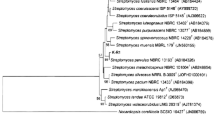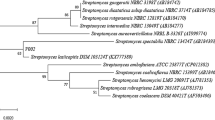Abstract
Endophytic actinomycetes are a rich source of novel antimicrobial compounds. The aim of this study was to evaluate the production of antimicrobial compound by endophytic Streptomyces sp. Av-R5 associated with root of Aloe vera against multidrug-resistant human pathogens. The 16S rRNA sequence of the isolate Av-R5 has been identified as Streptomyces parvulus NBRC 13193T (AB184326) and the sequence was submitted to the National Center for Biotechnology Information (NCBI) GenBank database (accession number KY771080). Streptomyces parvulus Av-R5 grown under submerged fermentation condition optimized by central composite design (glucose 11.16 g/L, soybean meal 10.25 g/L, sodium chloride 11.18 g/L, calcium carbonate 1.32 g/L at pH 7.19 at 31.42 °C with 6.04% seed inoculum for 10 days of incubation) exhibited the highest activity against multidrug-resistant Staphylococcus aureus JNMC-3, Staphylococcus epidermidis JNMC-4, Klebsiella pneumoniae MTCC-3384, Klebsiella pneumoniae JNMC-6, Pseudomonas aeruginosa MTCC-741, Proteus vulgaris JNMC-7, Candida albicans MTCC-183, and Aspergillus niger MTCC-872. The structures of the active compounds were elucidated by UV-Vis spectroscopy, 1H and 13C NMR, FT-IR, and ESIMS. Actinomycin D and actinomycin X0β were detected in crude extracts and major components were eluted by HPLC at 10.96 and 6.81 min, respectively. In this case, a high yield of actinomycin D and actinomycin X0β (400 mg/L) was achieved with Streptomyces parvulus Av-R5, fermented in glucose soybean meal broth media, which can be used in industrial fermentation process to obtain high yields.





Similar content being viewed by others
References
Alanis AJ (2005) Resistance to antibiotics: are we in the post antibiotic era? Arch Med Res 36:697–705
Strobel G, Daisy B, Castillo U, Harper J (2004) Natural products from endophytic microorganisms. J Nat Prod 67:257–268
Qin S, Li J, Chen HH, Zhao GZ, Zhu WY, Jiang CL, Xu LH, Li WJ (2009) Isolation, diversity and antimicrobial activity of rare actinobacteria from medicinal plants of tropical rain forests in Xishuangbanna, China. Appl Environ Microbiol 75:6176–6186
Kulkarni M, Gorthi S, Banerjee G, Chattopadhyay P (2017) Production, characterization and optimization of actinomycin D from Streptomyces hydrogenans IB310 (an antagonistic bacterium against phytopathogens). Biocatal Agric Biotechnol 10:69–74
Igarashi Y (2004) Screening of novel bioactive compounds from plant associated actinomycetes. Actinomycetol 18:63–66
Castillo UF, Strobel GA, Mullenberg K, Condron MM, Teplow DB, Folgiano V, Gallo M, Ferracane R, Mannina L, Viel S, Codde M, Robison R, Porter H, Jensen J (2006) Munumbicins E-4 and E-5: novel broad spectrum antibiotics from Streptomyces NRRL 3052. FEMS Microbiol Lett 255:296–300
Hasegawa T, Lechevalier MP, Lechevalier HA (1978) A new genus of the Actinomycetales, Actinosynnema genus novel. Int J Syst Bacteriol 28:304–310
El-Tarabily KA (2003) An endophytic chitinase producing isolate of Actinoplanes missouriensis with potential for biological control of root rot of lupine caused by Plectosporium tabacinum. Aust J Bot 51:257–266
Coombs JT, Michelsen PP, Franco CMM (2004) Evaluation of endophytic actinobacteria as antagonists of Gaeumannomyces graminis var. tritici in wheat. Biol Control 29:359–366
Cao LX, Qiu ZQ, You JL, Tan HM, Zhou S (2005) Isolation and characterization of endophytic Streptomycete antagonists of Fusarium wilt pathogen from surface sterilized banana roots. FEMS Microbiol Lett 247:147–152
El-Tarabily KA, Nassar AH, Sivasithamparam K (2009) Plant growth promotion and biological control of Pythium aphanidermatum a pathogen of cucumber by endophytic actinomycetes. J Appl Microbiol 106:13–26
Sousa MFVQ, Lopes CE, Pereira NJ (2002) Development of a bioprocess for the production of actinomycin D. Braz J Chem Eng 19:277–285
Praveen V, Tripathi CKM, Bihari V, Srivastava SC (2008) Production of actinomycin D by the mutant of a new isolate of Streptomyces sindenensis. Braz J Microbiol 39:689–692
Hamza AA, Ali HA, Clark BR, Murphy CD, Elobaid EA (2013) Isolation and characterization of actinomycin D producing Streptomyces sp. from Sudanese soil. Afr J Biotechnol 12:2624–2632
Zhu CH, Lu FP, He YN, Han ZL, Du LX (2007) Regulation of avilamycin biosynthesis in Streptomyces viridochromogenes: effects of glucose, ammonium ion and inorganic phosphate. Appl Microbiol Biotechnol 73:1031–1038
Chandrakar S, Gupta AK (2015) Antibiotic potential of endophytic actinomycetes of medicinal herbs against human pathogenic bacteria. Proc Natl Acad Sci, India, Sect B Biol Sci 87:905–915
Shirling EB, Gottlieb D (1966) Methods for characterization of Streptomyces species. Int J Syst Bacteriol 16:313–340
Kawato M, Shinobu R (1959) Cover slip culture of Streptomyces herbaricolour nov. sp. supplement; a simple technique for the microscopical observation. Mem Osaka Univ Lib Arts and Educ 8:114–119
Pridham TG, Gottlieb D (1948) The utilization of carbon compounds by some Actinomycetales as an aid for species determination. J Bacteriol 56:107–114
Jeon YS, Lee K, Park SC, Kim BS, Cho YJ, Ha SM (2014) EzEditor: a versatile sequence alignment editor for both rRNA-and protein-coding genes. Int J Syst Evol Microbiol 64:689–691
Tamura K, Peterson D, Peterson N, Stecher G, Nei M, Kumar S (2011) MEGA5: molecular evolutionary genetics analysis using maximum likelihood, evolutionary distance, and maximum parsimony methods. Mol Biol Evol 28:2731–2739
Balagurunathan R, Subramanian A (1993) Studies on marine Streptomyces nigrifaciens taxonomy and standardization of antibiotic production. Cienc Mar 19:435–443
Munimbazi C, Bullerman LB (1998) Isolation and partial characterization of antifungal metabolites of Bacillus pumilus. J Appl Microbiol 84:959–968
Carvalho T, Sand SVD (2016) Evaluation of antimicrobial activity of the endophytic actinomycetes R18 (6) against multiresistant gram-negative bacteria. An Acad Bras Cienc 88:155–163. https://doi.org/10.1590/0001-3765201620140655
Solanki R, Kundu A, Das P, Khanna M (2015) Characterization of antimicrobial compounds from Streptomyces sp. World J Pharm Res 4:1626–1641
Zhang X, Ye X, Chai W, Lian XY, Zhang Z (2016) New metabolites and bioactive actinomycins from marine derived Streptomyces sp. ZZ338. Mar Drugs 14:181–189
Gos FMWR, Savi DC, Shaaban KA, Thorson JA, Aluizio R, Possiede YM, Rohr J, Glienke C (2017) Antibacterial activity of endophytic actinomycetes isolated from the medicinal plant Vochysia divergens (Pantanal, Brazil). Front Microbiol 8. https://doi.org/10.3389/fmicb.2017.01642
Zhao S, Liu C, Zheng W, Ma Z, Cao T, Zhao J, Yan K, Xiang W, Wang X (2017) Micromonospora parathelypteridis sp. nov., an endophytic actinomycetes with antifungal activity isolated from the root of Parathelypteris beddomei (Bak.) Ching. Int J Syst Evol Microbiol 67:268–274
Salam N, Khieu TN, Liu MJ, Vu TT, Ky SC, Quach NT, Phi QT, Narsing Rao MP, Fontana A, Sarter S, Li WJ (2017) Endophytic actinobacteria associated with Dracaena cochinchinensis Lour: isolation, diversity and their cytotoxic activities. Biomed Res Int 2017:1–11. https://doi.org/10.1155/2017/1308563
Khieu TN, Liu MJ, Nimaichand S, Quach NT, Ky SC, Ph QT, Vu TT, Nguyen TD, Xiong Z, Prabhu DM, Li WJ (2015) Characterization and evaluation of antimicrobial and cytotoxic effects of Streptomyces sp. HUST012 isolated from medicinal plant Dracaena cochinchinensis Lour. Front Microbiol 6. https://doi.org/10.3389/fmicb.2015.00574
Taechowisan T, Wanbanjob A, Tuntiwachwuttikul P, Taylor WC (2006) Identification of Streptomyces sp. Tc022, an endophyte in Alpinia galanga, and the isolation of actinomycin D. Ann Microbiol 56:113–117
Lee JH, Kim YG, Lee K, Kim CJ, Park DJ, Ju Y, Lee JC, Wood TK, Lee J (2016) Streptomyces-derived actinomycin D inhibits biofilm formation by Staphylococcus aureus and its hemolytic activity. Biofoul 32:45–56
Rahman MA, Islam MZ, Khondkar P, Islam MA (2010) Characterization and antimicrobial activities of a polypeptide antibiotic isolated from a new strain of Streptomyces parvulus. Bangladesh Pharm J 13:14–17
Shetty PR, Buddana SK, Tatipamula VB, Naga VVV, Ahmad J (2014) Production of polypeptide antibiotic from Streptomyces parvulus and its antibacterial activity. Braz J Microbiol 45:303–312
Usha R, Ananthaselvi P, Venil CK, Palaniswamy M (2010) Antimicrobial and antiangiogenesis activity of Streptomyces parvulus KUAP106 from mangrove soil. Eur J Biol Sci 2:77–83
Chen C, Song F, Wang Q, Abdel-Mageed WM, Guo H, Fu C, Hou W, Dai H, Liu X, Yang N, Xie F, Yu K, Chen R, Zhang L (2012) A marine-derived Streptomyces sp. MS449 produces high yield of actinomycin X2 and actinomycin D with potent anti-tuberculosis activity. Appl Microbiol Biotechnol 95:919–927. https://doi.org/10.1007/s00253-012-4079-z
Williams WK, Katz E (1977) Development of a chemically defined medium for the synthesis of actinomycin-D by Streptomyces parvulus. Antimicrob Agents Chemother 11:281–290
Katz E, Pienta P, Sivak A (1956) The role of nutrition in the synthesis of actinomycin. Appl Microbiol 6:236–241
Gallo M, Katz E (1972) Regulation of secondary metabolite biosynthesis catabolic repression of phenoxazinone synthase and actinomycin formation by glucose. J Bacteriol 109:659–667
Sousa MFVQ, Lopes CE, Junior NP (2001) A chemically defined medium for production of actinomycin D by Streptomyces parvulus. Braz Arch Biol Technol 44:227–231
Meienhofer J, Atherton E (1973) Structure activity relationship in the actinomycins. Adv Appl Microbiol 16:203–300
Praveen V, Tripathi CKM (2009) Studies on the production of actinomycin-D by Streptomyces griseoruber—a novel source. Lett Appl Microbiol 49:450–455
Wei Z, Xu C, Wang J, Lu F, Bie X, Lu Z (2017) Identification and characterization of Streptomyces flavogriseus NJ-4 as a novel producer of actinomycin D and holomycin. Peer J 5:e3601. https://doi.org/10.7717/peerj.3601
Praveen V, Tripathi CKM, Bihari V (2008) Studies on optimum fermentation conditions for actinomycin D production by two new strains of Streptomyces spp. Med Chem Res 17:114–122
Kurosawa K, Bui VP, Van EJL, Willis LB, Lessard PA, Ghiviriga I, Sambandan TG, Rha CK, Sinskey AJ (2005) Characterization of Streptomyces MITKK-103, a newly isolated actinomycin X2 producer. Appl Microbiol Biotechnol 72:145–154
Acknowledgements
Authors are thankful to the Head, SLS, PRSU, Raipur, for providing the necessary facilities for the research. The authors also thank Microbial Type Culture Collection and Gene Bank (MTCC), Chandigarh for providing cultures and Pandit Jawaharlal Nehru Medical College, Raipur, Chhattisgarh for providing clinical cultures for research.
Funding
This study was funded by University Grant Commission, New Delhi, India (F.7-145/2007BSR) and granted financial support from DST, New Delhi under FIST program and UGC, New Delhi for DRS-SAP III.
Author information
Authors and Affiliations
Corresponding author
Ethics declarations
Conflict of Interest
The authors declare that they have no conflict of interest.
Ethical Approval
This article does not contain any studies with human participants or animals performed by any of the authors.
Electronic Supplementary Material
ESM 1
(DOCX 1891 kb)
Rights and permissions
About this article
Cite this article
Chandrakar, S., Gupta, A.K. Actinomycin-Producing Endophytic Streptomyces parvulus Associated with Root of Aloe vera and Optimization of Conditions for Antibiotic Production. Probiotics & Antimicro. Prot. 11, 1055–1069 (2019). https://doi.org/10.1007/s12602-018-9451-6
Published:
Issue Date:
DOI: https://doi.org/10.1007/s12602-018-9451-6




